Catherine Delors's Blog
January 27, 2020
A letter from Auschwitz

These stamps are affixed to one of the most moving artifacts I hold: a letter, dated February 23, 1945, written by Professor Henri Limousin, a French prisoner, following his liberation from Auschwitz. It was passed down my family. Here is my translation:
Dear Sir:
I have the pleasure to inform you that I have been recently liberated by the Russian army, following dramatic adventures, which I hope to be able to tell you in person soon, since we have been promised a prompt repatriation. My health is now improving, thanks to a substantial diet and better moral conditions. I hope you and your family are in good health, and that life has returned to its normal course in Clermont. I would be happy to have some news from you.
Very truly yours.
H. Limousin, Inmate No. 200213
Freed from Auschwitz Camp, Upper Silesia, c/o the French Embassy in Moscow, via the Ministry of Foreign Affairs.
This is it: a single sheet of paper, stamped and addressed on the back, no envelope. Think of its journey: from the barracks of Auschwitz to the French Embassy in Moscow, and then on to Auvergne. How I wish I knew of the “dramatic adventures” Limousin wanted to recount. A member of the Resistance and a professor at the medical school of the University of Clermont-Ferrand, in Auvergne, he had been arrested in March 1944.
I found an echo of his Auschwitz experience in the Nuremberg Trial archives by way of the testimony of Dr. Franz Blaha, a Czech physician prisoner and the camp’s chief pathologist. Professor Limousin told him that, out of his transport of approximately 2,000 persons, 800 died en route during the 12-day journey from France, bodies discarded along the way. That was 12 days in the heat without anything to drink. The train arrived at Auschwitz with 500 corpses on board. That left approximately 700 survivors, most of whom died shortly afterwards.
Dr. Blaha remembered this transport well, because he was ordered by the SS to perform autopsies on the French transport victims, and found that they had died of asphyxiation and dehydration. This autopsy request followed inquiries from the Red Cross about this transport’s high death toll (yes, the Red Cross monitored such atrocities) and the SS contended that the deportees had simply fought in the cattle cars and killed each other. As Blaha recalled, detailed reports followed such inquiries, and nothing ever changed.
Blaha also remembered that Professor Limousin arrived “in very poor condition.” Somehow he pulled through and was chosen by Blaha to become his assistant. Both men survived and Blaha went on to testify at Nuremberg about the “medical experiments” performed by SS doctors in the camps. Professor Limousin died in 1966, having survived 21 years after his liberation.
The United States Holocaust Memorial Museum posts a video of Dr. Blaha’s testimony at the Nuremberg Trial (in German).
The passage of time gives us all the more reason to treasure the testimony of Auschwitz eyewitnesses – and great writers – Elie Wiesel and Primo Levi. Claude Lanzmann’s harrowing 9-hour documentary Shoah is a must-watch. Listen to the dead…

December 24, 2019
An Interview of Susanne Dunlap, author of THE SPIRIT OF FIRE
Susanne Dunlap has just released THE SPIRIT OF FIRE, the second installment (already!) of her acclaimed ORPHANS OF TOLOSA trilogy, set during the 13th century during the crusade against the Cathar heresy, in a place that would soon become part of France. She kindly agreed to answer a few questions.

What made you choose a French setting, and this era?
Well, first of all, I’m a huge Francophile! Also, what really got me interested in the place and time was learning about the amazing women troubadours who wrote poetry and music for only about 80 years at that time. This region (now called Occitanie) wasn’t part of France at the time, but an autonomous that was a patchwork of baronies and counties, whose lords owed fealty to the count of Toulouse, the King of Aragon, the Holy Roman Emperor, and sometimes, yes, King Louis IX of France. It was a time and place that was comparatively tolerant of different religions, and there was no primogeniture. Unmarried women had to be left an equal share of the property when someone with land died. They had their own language, as well — Occitan — which is closer linguistically to Catalan and Spanish than French. This was all destroyed and later subsumed into France. Although there’s been a movement to bring back Occitan, and street signs etc. are now in both French and Occitan in that part of France.
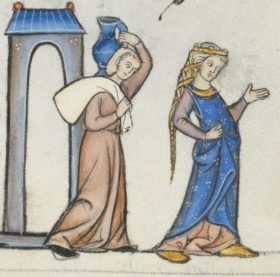
What are the challenges of research like for that period?
Anything from the 13th century is a challenge because there are limited sources. However, that does give a writer a lot of latitude for inventing things, which I took full advantage of!
What surprised in the course of your research?
I was actually very surprised about the winemaking tradition in the region. Wines were drunk the year they were made; there was no aging and storing of vintages. And the region has really wonderful wines now—much better value than those from the well-known terroirs.
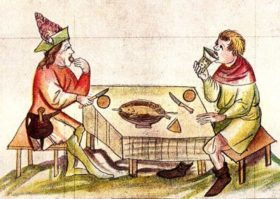
What makes the story of the orphans of Tolosa relevant to today’s readers?
I think this biggest thing is that the story revolves around religious persecution, wars against a peaceful sect, the Cathars, who were Christians, just not Catholics. I think it’s important to be reminded of the many atrocities committed in the name of religion at all times in history.
What are the challenges of writing a trilogy?
The biggest challenge is in creating a story that’s big enough to stretch across three books!
After the success of Game of Thrones, do you see a blurring of the line between accurate medieval historical fiction and fantasy?
I don’t know, really. I still think historical fiction and fantasy are quite separate. And although I did my research thoroughly and the historical events in my trilogy happened, all my characters are fictional as are most of the smaller events. But no dragons. I draw the line at dragons.
Thanks for the interview! And merry Christmas to you as well! Or, I should say, joyeux Noel!
Joyeux Noel to you, Susanne, and to all the readers of Versailles and More!
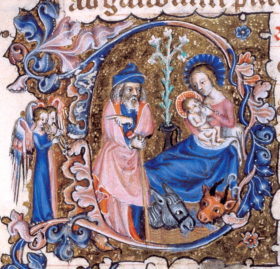

December 18, 2019
THE GHOST OF MADISON AVENUE, by Nancy Bilyeau
I love Nancy Bilyeau’s novels and needed a fast read to distract me from thoughts that had been weighing me down during this Advent season. So, I purchased THE GHOST OF MADISON AVENUE.
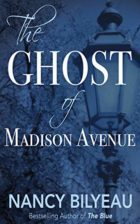
A fast read it was (it’s a novella) but one that will stay with me. In ten chapters, Bilyeau weaves many threads: New York during the Gilded Age, the wonders of the Morgan Library, the barely met but ever present J. P. Morgan himself, the close-knit and diverse Irish-American community, family ties that bind, hurt and heal, and twin stories of love lost. Of course, as the title indicates, this is also a ghost story. But here the supernatural, as in the Sister Joanna trilogy, guides the arc of the story without veering into horror tricks.
We meet Helen O’Neill, a middle-aged widow and denizen of the Bronx. She has never recovered from the untimely death of her husband but finds some solace in the embrace of her upwardly mobile family, and her own professional achievements. She has just been hired by Belle da Costa Greene, Morgan’s fascinating librarian, to tend to the treasures of his collection. Because Helen has a gift with ancient artifacts. A gift best described by ancestral Irish lore. Certainly a gift that has allowed her to rise from kitchen hand to unofficial conservator at the Metropolitan Museum of Art. Maybe the same gift that makes her notice an oddly dressed young woman on Madison Avenue.
As with every great read, the turning of the last page opens more doors. I now want to return to the Morgan Library to look at it with a new eye. I also want to learn more about J. P. Morgan and his librarian, Belle da Costa Greene. Yes, she is a historical character.
THE GHOST OF MADISON AVENUE helps us refocus on the true meaning of the season, on our loved ones, present and departed, how much we miss those we lost, and how we wish their ghostly presence would watch over us through the trials of life.


January 27, 2017
Hello world!
Welcome to WordPress. This is your first post. Edit or delete it, then start writing!

May 8, 2016
Happy Mother’s Day!
With Le Berceau (The Cradle), by Berthe Morisot, one of the great ladies of Impressionism. Enjoy the day! [image error]

Berthe_Morisot_Le_berceau_The_Cradle_1872

June 17, 2014
An interview of Nancy Bilyeau, author of THE CHALICE
As I read THE CHALICE, my friend Nancy Bilyeau’s new novel in the Joanna Stafford series, I found that I couldn’t put it down until I was done with it. Nancy kindly agreed to answer a few questions for the readers of Versailles and More.

The Chalice by Nancy Bilyeau
Just when I thought that Tudor fiction had been written to death, I came across THE CHALICE. What is novel about it, no pun intended, is the focus, not on Henry VIII, nor his ill-fated queens, nor Cromwell, nor any other major figure, but on ordinary people. You made me realize how terrifying, how deeply disorienting, it must have been for Henry’s subjects to go through the religious upheavals of his reign. And then your heroine is a devout Catholic nun, Sister Joanna, while usually the era is seen from an Anglican or Protestant standpoint. What drove you to this perspective?
I decided that since I love the Tudor period and I am also a devotee of the mystery genre, I would write a Tudor thriller. But I didn’t want to write a real-life historical personage as the main character, and if you want to write a novel in which mysteries are solved, there are obstacles. There was no police as we know it in the 16th century. You had in positions of authority sheriffs and coroners and unpaid constables–and I make use of that in my series–and there were night watchmen. But you certainly didn’t have the use of forensics or ability to investigate a murder as we understand it now. So I thought I would create a different sort of story–more of a thriller than a traditional murder mystery–and a different sort of protagonist, too, someone who is thrown into the middle of important times, and I came up with a nun. After I researched the backgrounds and perspectives of nuns and monks and friars in the Tudor age, I came to far different conclusions than most novelists do about the Reformation. The monastic orders played an important role in society. I formed a deep sympathy for the nuns, in particular. It distresses me, the anti-Catholic prejudice that began in the 1530s and has raged on ever since in England. Hilary Mantel says Catholicism is not a religion for respectable people? I disagree with her, of course, and yet you can see why she would be the perfect writer for Thomas Cromwell’s story, if that is how she feels.
While reading THE CHALICE, I got a strong sense of being thrown into Tudor times. One recognizes, of course, the major historical events and characters. But which parts of the story, which characters are fictional? Were prophecy and necromancy, which are crucial to the plot, part of the political scene?
I enjoy mixing real people with fictional characters. It is, quite simply, fun. But also I think it’s important to depict people and events that were of great importance in this period. There has been a tendency to emphasize the royal marriages to the exclusion of all else. But so much else was happening. Within a four year period, England suffered a popular revolt, and was also at risk of invasion in a joint campaign by Spain and France. There were threats from within and without, which does make Henry VIII’s paranoia a little more understandable. In “The Chalice” I write about the Exeter Conspiracy, a terrifying lashing out at Henry’s closest relatives and friends. As for belief in prophecy, it was woven into daily lives along with beliefs in astrology and alchemy. The Tudors themselves tried to use the power of prophecy. Henry VII when he came to the throne said he was descended from Arthur–he even produced “evidence” from genealogists–and of course named his oldest son Arthur and drew on the cryptic wisdom of Merlin to support his claim. But he unleashed forces he could not control. Henry VIII was dogged by rebels and critics spouting prophecy, some of it supposedly based on Merlin. I read something very interesting, that when a society is under great strain, belief in prophecy rises. People long for answers and meaning.
I loved THE CHALICE not only as a historical, but also as a thriller and adventure novel, a la Da Vinci Code, but with developed characters and a concern for historical accuracy. What books and authors inspired you in this regard?
There are so many! In historical fiction I was inspired by those who I read when I was young–I suppose you could say I was formed by them. The most important were Daphne du Maurier, Norah Lofts, Mary Stewart and Anya Seton. More recently, I’ve been inspired by the work of Mary Renault, Ellis Peters and Robert Graves. I really love Katherine Neville’s “The Eight,” A.S. Byatt’s “Obsession,” Kate Moses’s “Labyrinth,” “Sepulcher,” and “Citadel,” and Elizabeth Kostova’s “The Historian.”

Nancy Bilyeau
I do hope we are going to hear more of the adventures of Sister Joanna. The Chalice begins after the death of Jane Seymour, and ends with Henry’s marriage to lovely, and unloved, Anne of Cleves. We still have two of Henry’s queens to go, and then Edward, Mary and Elizabeth! We even get glimpses of a very young Catherine Howard… Are you working on more Joanna Stafford novels?
I just finished writing the third book, “The Covenant,” which follows Joanna through her most frightening challenge yet: Someone is trying to kill her. The story picks up right where “The Chalice” leaves off in the spring of 1540 and takes readers up to the end of 1541. By that time, Anne of Cleves has been divorced, and Catherine Howard has become Henry’s fifth queen. Cromwell is dead, and Bishop Stephen Gardiner, Joanna’s mentor and nemesis, is upper hand at last. It’s a topsy-turvy time.
“The Covenant” completes my planned trilogy. I am working on another historical thriller, a novel that has a more personal connection. But I do have other ideas for Joanna Stafford, and it’s possible that I will write a second trilogy of Joanna novels. I really want to bring Joanna forward to the reigns of the children of Henry VIII, and particularly the Marian Counter-Reformation!
Thank you, Nancy, and I look forward to this final installment!

March 26, 2014
The Berkeley Square Affair, by Teresa Grant

the berkeley square affair
Today it is my pleasure to welcome as a guest blogger my friend and fellow author Teresa Grant, whose new novel, The Berkeley Square Affair, was released yesterday. Congratulations, Teresa, and welcome to Versailles and More!
======================================
After five years, three books, and two novellas of adventures on the Continent (in Lisbon, Vienna, Brussels during Waterloo, and post-Waterloo Paris) my new release brings Malcolm and Suzanne Rannoch to England. But the Continent and France in particular still hang over their lives and the plot of the book, The world of the British beau monde, to which the husband and wife spy team have removed after their adventures on the Continent, has long standing links across the channel. Aristocrats of Malcolm’s parents’ generation, such as the real life Duke and Duchess of Devonshire (below) and the duchess’s sister Lady Bessborough and her husband spent a great deal of time in Paris before the French Revolution and in the early days of he Revolution the duchess went to France to give birth in secret to her child by Charles Grey.
Young aristocrats fresh from Oxford and Cambridge made the Grand Tour and brought back works of art to fill their houses. The British flocked to Paris again during the brief Peace of Amiens in 1802. When hostilities with Napoleon’s government broke out again, such as novelist Fanny Burney had to stay until after Waterloo. After Waterloo, fashionable London once again crossed the Chanel, including the Devonshires’ sonny then the duke himself, and their daughter Harriet and her husband Lord Granville.
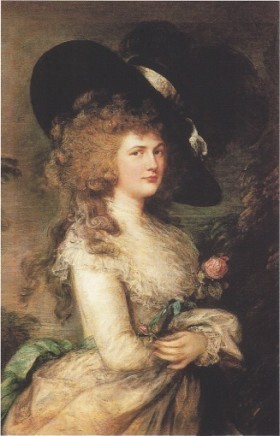
Georgiana Devonshire
But in the aftermath of the French Revolution, when the Revolutionary and Napoleonic Wars largely closed the Continent to British travelers, it was French aristocrats fleeing the Revolution who flocked to Britain. The Comte d’Artois, later Charles X escaped to Britain in the aftermath of the Revolution and lived in Edinburgh and London, with a generous allowance from George III. In 1807 his elder brother Louis XVIII fled the Continent and took up residence in Norfolk in Gosfield Hall, leased from the Marquess of Buckinghamshire.
Families like my fictional Lacloses and the real life Duc and Duchesse de Gramont settled into life in Britain. At first an air of romance surrounded them, but the émigrés were largely penniless and as time wore on their welcome began to pall. Those with powerful friends fared better. The Gramonts were friends of the Devonshires. Their daughter, Corisande de Gramont, grew up close to the Devonshire House children and married Lord Ossulton. But even émigrés with friends were in the not always comfortable position of depending on their friends’ charity. Those without powerful friends often subsisted in genteel poverty.
In the wake of Waterloo, many émigrés returned to France, seeking to have their estates restored. But others sought refuge in England. Charles de Flahaut, who had been Napoleon’s aide-de-camp, narrowly escaped arrest or formal exile with the help of his father Prince Talleyrand (Flahaut was Talleyrand’s illegitimate son though nominally the son of his mother’s husband).

Teresa Grant
Flahaut, who was also the former longtime lover of Hortense Bonaparte, the Empress Josephine’s daughter, sought refuge in England and married the Scottish heiress Margaret Mercer Elphinstone. Not that Flahaut precisely found an unconditionally warm welcome in England either. His wife’s father didn’t talk to them for many years.
My fictional character actress Manon Caret, also seeks refuge in England. A former Bonapartist agent, Manon, escaped France in the previous book in the series The Paris Affair one step ahead of Fouché‘s agents.
So the London of late November 1817 in which Malcolm and Suzanne are living when The Berkeley Square Affair begins is a city that, despite years of war, has close political and personal ties to France and its glittering capital, Paris.

April 24, 2013
Marie-Antoinette, simple elegance and the secrets of Versailles

Marie-Antoinette “en gaulle” by Vigee-Lebrun
Truth be told, Marie-Antoinette as a teenager and young woman very much enjoyed the outrageous hairstyles of her time, and during all of her years at Versailles she had to wear the court dress for all formal occasions.
But it is true that, as her taste matured, she came to appreciate the freedom of simple linen dresses. She even had her portrait painted in one of those by her favorite artist, Elisabeth Vigée-Lebrun (left.)
Alas, that painting, to our modern eye far more modest than the low-cut court gowns, created a full-blown scandal: the Queen had herself painted in her chemise!
Imagine, to have an idea of the uproar at the time, the stunned reaction if we were to behold a portrait of the First Lady in her undergarments. It was much worse then, of course, because the royal person was in itself sacred. It was all right, and indeed required, for the Queen to change her chemise in front of the courtiers, or to give birth in public, but being painted in a linen dress was going where no other Queen of France had tread before.
Here is a link to a preview and presentation of the Marie-Antoinette program, to be broadcast on History on Thursday, April 25th at 9 pm ET/PT on HISTORY® (Canada), and another link to the preview of Secrets of Versailles.
Enjoy!

April 12, 2013
The Paris Affair, by Teresa Grant
Remember my novel, For The King, where I introduced the rather repulsive (but historically correct) character of Joseph Fouché? Well, fellow author Tracy Grant offers another story featuring Napoléon’s least favorite and most indispensable minister. She kindly agreed to write this guest post for the readers of Versailles and More:

The Paris Affair by Teresa Grant
The battle of Waterloo may have ended the major fighting in the Napoleonic Wars, but it was far from bringing an end to the simmering tensions of the past quarter century. When Napoleon escaped from the field at Waterloo, Louis XVIII was still in exile in Ghent. it was by no means a foregone conclusion that he would return to power. Much of the negotiating for France in the immediate aftermath of the battle was done by two men whose careers had been closely intertwined with that of Napoleon Bonaparte and with the Revolution – Charles Maurice de Talleyrand-Périgord and Joseph Fouché.
Prince Talleyrand, Napoleon’s former foreign minister (though he had left office well before Napoleon’s exile) had survived in the first Bourbon restoration to represent France at the Congress of Vienna and had not rejoined Napoleon when Bonaparte escaped from Elba.
Fouché, Napoleon’s minister of police for much of his rule, had worked with the Allies against Napoleon in 1814 but then rejoined Napoleon after his escape from Elba and served as his minister of police during the Hundred Days. After Napoleon’s resignation was demanded by the Chamber of Deputies following Waterloo, Fouché became head of the provisional government and negotiated with the victorious Allies (whom Talleyrand had joined).
Louis XVIII was a weak king and the Allies saw the need to keep both Talleyrand and Fouché to fill the power vacuum, at least temporarily. In fact it was Talleyrand, the former revolutionary, who argued strenuously for that a restored monarchy would, in his mind, offer the most stability. Talleyrand became Prime Minister and asked Fouché to stay on as Minister of Police.
Emboldened by Napoleon’s second defeat, the Ultra Royalist faction, led by Louis XVIII’s brother the Comte d’Artois, wanted vengeance on those who had gone over to Napoleon during the Hundred Days (and really for everything since the Revolution). Though the Ultra Royalists despised Fouché as a regicide who had voted for the execution of Louis XVI, it was Fouché who recieved denunciations against former Bonapartists.

Teresa Grant
Fouché, expert at using terror to maintain control (and preserve his own position) played a key role in carrying out the White Terror against Bonapartists (and suspected Bonapartists) who were proscribed from the amnesty, though the Ultra Royalists went too far even for him. Talleyrand advocated a more temperate approach and made the best of a weak hand as he negotiated with the Allies. He exerted his influence to keep his illegitimate son, Charles de Flahaut (also the lover of Hortense Bonaparte), who had fought for Napoleon at Waterloo, off the proscribed list. Charles de la Bédoyère, who had taken his regiment over to Napoleon after his escape from Elba and been one of the last to leave the field after Waterloo, slipped back into Paris to say goodbye to his wife and baby son before going into exile and was arrested and later executed.
Ultra Royalist gangs attacked Bonapartists in the south. Allied soldiers – British, Prussian, Dutch-Belgian, Bavarian – thronged the boulevards and quais of Paris and were encamped in the Bois de Boulogne, leading to frequent tension with the French populace. Many Parisians were far from eager for a return of the Bourbon monarchy, and even those who hadn’t supported Napoleon were not necessarily sanguine about foreign troops thronging the city. Royalist émigrés, many of whom had fled France two decades ago, returned seeking to have their estates restored.
Talleyrand meanwhile faced personal turmoil as well. His nephew’s young wife Dorothée, who had served as Talleyrand’s hostess at the Congress of Vienna, had returned to Paris but had taken up residence with Talleyrand rather than her husband Edmond q. Count Karl Clam-Martinitz, who had become her lover in Vienna, was in Paris as well. But Talleyrand had strong feelings for Dorothée himself and was arguably in love with her. Dorothée’s sister Wilhelmine, the Duchess of Sagan, was also in Paris. The twice-divorced duchess was involved in a liaison with Lord Stewart, the hot-tempered half-brother of Lord Castlereagh, the British foreign secretary. Castlereagh was handling the negotiations for the British, in concert with the Duke of Wellington. .
Malcolm and Suzanne Rannoch step into this glittering, simmering cauldron in The Paris Affair. The mystery they investigate twists through the glamorous veneer of Restoration Paris and the smoldering tensions beneath. Talleyrand, Fouché, Dorothée, Wilhelmine, Stewart, Castlereagh, and Wellington are all major characters. I loved writing about Waterloo in Imperial Scandal but I found its aftermath every bit as intriguing to explore.

English-versus-French-fashion

February 23, 2013
From Virginia Woolf to Jane Austen: a personal journey

Virginia Woolf
As a law student in Paris years ago, I felt I was coming down with the flu and pushed the door to my neighborhood bookstore. I needed to purchase something to while away the unpleasantness to come.
I browsed the shelves and picked up a paperback titled Orgueil et Préjugés, by one Jane Austen, an author I had never heard of. Indeed, for some unfathomable reason, she remains fairly obscure in France. I read the foreword, and that at least was by a very famous writer, one I had read before with great admiration: Virginia Woolf. It turns out that the preface to this French edition was the translation of A Room of One’s Own…
And what things did Virginia have to say about this unknown Miss Austen!
One after another she creates her fools, her prigs, her worldlings, her Mr. Collinses, her Sir Walter Elliotts, her Mrs. Bennets. She encircles them with the lash of a whip-like phrase which, as it runs round them, cuts out their silhouettes for ever. But there they remain; no excuse is found for them and no mercy shown them. Nothing remains of Julia and Maria Bertram when she has done with them; Lady Bertram is left “sitting and calling to Pug and trying to keep him from the flower-beds” eternally. A divine justice is meted out; Dr. Grant, who begins by liking his goose tender, ends by bringing on “apoplexy and death, by three great institutionary dinners in one week”. Sometimes it seems as if her creatures were born merely to give Jane Austen the supreme delight of slicing their heads off.
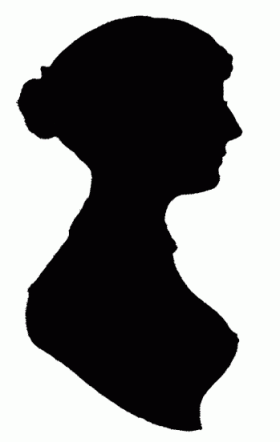
Jane Austen Silhouette
A novelist who delights in decapitating her characters? These words of Virginia Woolf sealed my choice, and in a way my literary fate. I hurried home with my paperback and my germs. The latter were gone in a matter of days, but the former would never leave me. I read Orgueil et Préjugés in one sitting, engrossed by the brilliance, the wit, the irony, the unsentimentality of Jane Austen. Then I reflected that it was but a translation (I was not yet a translator, and in my youthful arrogance disdained the achievements of that craft.) What if the English original were still better?
Once recovered, I headed for the library, and there I found the complete novels of Jane Austen waiting for me, in English editions. I began, of course, with Pride and Prejudice. At first I was a bit distrustful of my high school English, but soon forgot my misgivings as I became immersed into Jane’s prose. Her English became the only one I felt I knew.
Then I moved on to Emma, which I liked still far better than Pride and Prejudice, and Northanger Abbey, Sense and Sensibility, and finally my favorites, Mansfield Park and Persuasion. There was no going back. I read and reread those novels dozens of times, and they led me to other great works of English literature: the novels of George Elliott, Henry Fielding, Anthony Trollope, Emily Bronte, Elizabeth Gaskell and many others. I would never have met those but for my encounter with Jane Austen.
I took me many years to find my own inspiration and pen my first novel. I hesitated between writing it in my native French or my acquired English. But again Jane’s novels were there by my side. I knew them almost by heart, and whenever I hesitated on the turn of a sentence, I knew one of them would be at hand help me out of my dilemma.
I hasten to say that my own novels, in themes and characters, have little to do with Jane’s. But on occasion, while writing Mistress of the Revolution, I caught myself writing bits of dialog with her in mind. Those were cut from the final version because the novel was deemed too long, but they remain among my favorite passages, and I may post them here some day.
So, with all due humility, affection and admiration, I can say that Jane Austen taught me to write in English.




